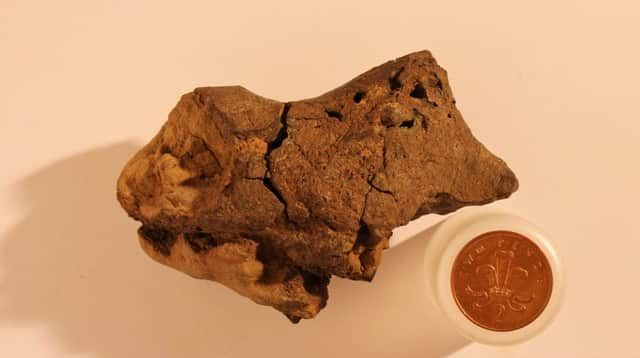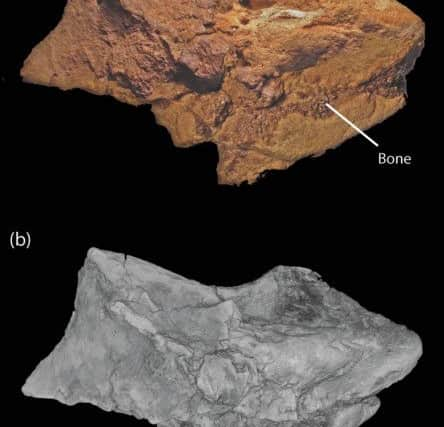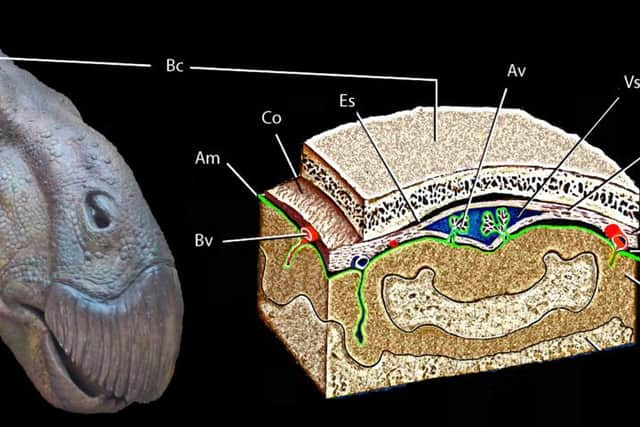Scientists hail '˜astonishing' dinosaur brain found in Bexhill


This article contains affiliate links. We may earn a small commission on items purchased through this article, but that does not affect our editorial judgement.
The unassuming brown pebble found more than a decade ago by a fossil hunter Jamie Hiscocks is the first example of fossilised brain tissue from a dinosaur, that lived 133 million years ago during the Early Cretaceous period.
Oxford and Cambridge university scientists believe it belongs to a species closely related to Iguanodon, a large herbivores which had a long tail for balance and hind legs that were longer than their fore limbs.
Advertisement
Hide AdAdvertisement
Hide AdAnd their brains displayed distinct similarities to the brains of modern-day crocodiles and birds.


Meninges - the tough tissues surrounding the actual brain - as well as tiny capillaries and portions of adjacent cortical tissues have been preserved as mineralised ‘ghosts’.
Co-author Dr Alex Liu of Cambridge’s Department of Earth Sciences said: “The chances of preserving brain tissue are incredibly small, so the discovery of this specimen is astonishing.”
The reason this particular piece of brain tissue has been so well-preserved is that the dinosaur’s brain was essentially ‘pickled’ in a highly acidic and low-oxygen bog or swamp shortly after its death.
Advertisement
Hide AdAdvertisement
Hide AdThis allowed the soft tissues to become mineralised before they decayed.


The study was published in a Special Publication of the Geological Society of London in tribute to the late Professor Martin Brasier of the University of Oxford, who died in 2014.
Prof Brasier and Dr David Norman from the University of Cambridge co-ordinated the research into this particular fossil during the years prior to his untimely death in a road traffic accident.
Fellow Dr Norman said: “What we think happened is that this particular dinosaur died in or near a body of water, and its head ended up partially buried in the sediment at the bottom.
Advertisement
Hide AdAdvertisement
Hide Ad“Since the water had little oxygen and was very acidic, the soft tissues of the brain were likely preserved and cast before the rest of its body was buried in the sediment.”
Working with colleagues from the University of Western Australia, the researchers used scanning electron microscope (SEM) techniques to identify the tough membranes, or meninges, that surrounded the brain itself, as well as strands of collagen and blood vessels.
Structures that could represent tissues from the brain cortex, its outer layer of neural tissue, interwoven with delicate capillaries, also appear to be present.
The structure of the fossilised brain, and in particular that of the meninges, shows similarities with the brains of modern-day descendants of dinosaurs, namely birds and crocodiles.
Advertisement
Hide AdAdvertisement
Hide AdIn typical reptiles, the brain has the shape of a sausage, surrounded by a dense region of blood vessels and thin-walled vascular chambers (sinuses) that serve as a blood drainage system.
The brain itself only takes up about half of the space within the cranial cavity.
In contrast, the tissue in the fossilised brain appears to have been pressed directly against the skull, raising the possibility that some dinosaurs had large brains which filled much more of the cranial cavity.